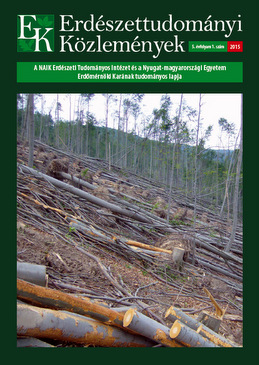Changes in the production of reproductive material in forest management from the years 1982-2014 (Quo vadis forest reproductive material production?)
István Bach, Norbert Frank, Beáta Pintér & Sándor Bordács
Correspondence
Correspondence: Bach István
Postal address: H-1024 Budapest, Keleti K. u. 24.
e-mail: Bachistvandr[at]yahoo.com
Abstract
Over the past decades, the forest reproductive material sector has changed significantly in Hungary. Societal, economic, and political developments have decisively influenced forest management, the results of which are reflected in the statistical indicators of the production of forest reproductive material. Analyses of statistical data point out relevant trends and changes, especially in ownership structure, total number of nurseries, mean size of nursery area, and proportion of tree species produced. In the early 1990s the formerly dominant state-owned nurseries were replaced by privately-owned ones, and large or medium size nurseries were replaced by small or even micro size farms. Simultaneously, the mean area of nurseries decreased drastically for about 10 years. As a consequence of slight reduction in total number of nurseries, the mean area, as well as the total volume of reproductive material produced by each nursery, has increased slightly since the 1990s. In general, relevant modifications in forestry policy, such as the increasing importance of close-to-nature forestry, modified preferences in the use of non-autochthonous tree species, and essential changes in afforestation programs have significantly affected the production structure of the forest nursery sector as well. For example, the production volume of reproductive material of conifers is far less than it was in the 1990s, but the production volume of scattered broadleaves is far greater than it was in the 1990s. Further variations in the structure of tree species can be expected due to the varying needs of climate change.
Keywords: forest reproductive material, forest nursery, production, trend
Open Acces
For non-commercial purposes, let others distribute and copy the article, and include in a collective work, as long as they cite the author(s) and the journal, and provided they do not alter or modify the article.
Cite this article as:
Bach, I., Frank, N., Pintér, B. & Bordács, S. (2015): Changes in the production of reproductive material in forest management from the years 1982-2014 (Quo vadis forest reproductive material production?). Bulletin of Forestry Science, 5(1): 55-69. (in Hungarian) DOI: 10.17164/EK.2015.004
Volume 5, Issue 1
Pages: 55-69
First published:
10 October 2015
Related content
4
More articles
by this authors
9
Related content in the Bulletin of Forestry Science*
(Forest reproductive materials production after the 2nd world war). Bulletin of Forestry Science, 10(1): 55-66.
More articles by this authors in the Bulletin of Forestry Science
* Automatically generated recommendations based on the occurrence of keywords given by authors in the titles and abstracts of other articles. For more detailed search please use the manual search.
